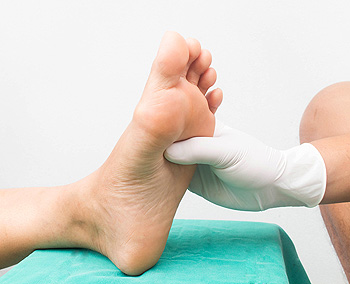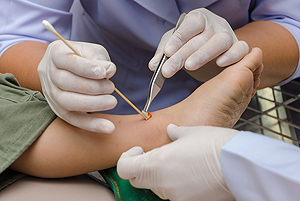Items filtered by date: July 2021
Methods That Can Help Diabetic Patients to Feel Better
 Diabetic foot is a condition that can require a hospital stay for some diabetic patients. It is a condition that may cause the patient to lose feeling in their feet, which can make it difficult to feel a cut or a bruise. It occurs as a result of elevated blood sugar levels. It is beneficial to control the amount of sugar that is ingested, and this is often helpful in keeping glucose levels within a normal range. Additionally, many patients find their feet feel better when they are gently washed and dried, and trimming the toenails correctly may help to avoid cuts on the toes. It is important to incorporate gentle exercise into your daily routine, as this may help to improve circulation and overall health. If you have diabetes, it is strongly suggested that you are under the care of a podiatrist who can help you to properly manage any foot-related problems that may arise because of this condition.
Diabetic foot is a condition that can require a hospital stay for some diabetic patients. It is a condition that may cause the patient to lose feeling in their feet, which can make it difficult to feel a cut or a bruise. It occurs as a result of elevated blood sugar levels. It is beneficial to control the amount of sugar that is ingested, and this is often helpful in keeping glucose levels within a normal range. Additionally, many patients find their feet feel better when they are gently washed and dried, and trimming the toenails correctly may help to avoid cuts on the toes. It is important to incorporate gentle exercise into your daily routine, as this may help to improve circulation and overall health. If you have diabetes, it is strongly suggested that you are under the care of a podiatrist who can help you to properly manage any foot-related problems that may arise because of this condition.
Diabetic foot care is important in preventing foot ailments such as ulcers. If you are suffering from diabetes or have any other concerns about your feet, contact Dr. Douglas Mckay from New Jersey . Our doctor can provide the care you need to keep you pain-free and on your feet.
Diabetic Foot Care
Diabetes affects millions of people every year. The condition can damage blood vessels in many parts of the body, especially the feet. Because of this, taking care of your feet is essential if you have diabetes, and having a podiatrist help monitor your foot health is highly recommended.
The Importance of Caring for Your Feet
- Routinely inspect your feet for bruises or sores.
- Wear socks that fit your feet comfortably.
- Wear comfortable shoes that provide adequate support.
Patients with diabetes should have their doctor monitor their blood levels, as blood sugar levels play such a huge role in diabetic care. Monitoring these levels on a regular basis is highly advised.
It is always best to inform your healthcare professional of any concerns you may have regarding your feet, especially for diabetic patients. Early treatment and routine foot examinations are keys to maintaining proper health, especially because severe complications can arise if proper treatment is not applied.
If you have any questions please feel free to contact one of our offices located in Caldwell, and Galloway, NJ . We offer the newest diagnostic and treatment technologies for all your foot and ankle needs.
What Bones Can Break In an Ankle Fracture?
 Your ankle is made up of three bones, all of which can be broken or cracked from an injury. The tibia is the larger of two main bones that make up your ankle. You can feel the lower end of it along the inside of your ankle. The fibula is the thinner of the two main ankle bones, and you can feel the lower end of this bone along the outside of your ankle. The talus is a wedge-shaped bone located deep inside the ankle, between the heel bone and the ends of the tibia and fibula. Ankle fractures are usually caused by a sudden, sharp twist of the ankle or a direct impact to the area. Symptoms include immediate, severe pain, swelling, bruising, tenderness, and difficulty walking. If you suspect that you may have fractured your ankle, it is strongly suggested that you seek the care of a podiatrist as soon as possible.
Your ankle is made up of three bones, all of which can be broken or cracked from an injury. The tibia is the larger of two main bones that make up your ankle. You can feel the lower end of it along the inside of your ankle. The fibula is the thinner of the two main ankle bones, and you can feel the lower end of this bone along the outside of your ankle. The talus is a wedge-shaped bone located deep inside the ankle, between the heel bone and the ends of the tibia and fibula. Ankle fractures are usually caused by a sudden, sharp twist of the ankle or a direct impact to the area. Symptoms include immediate, severe pain, swelling, bruising, tenderness, and difficulty walking. If you suspect that you may have fractured your ankle, it is strongly suggested that you seek the care of a podiatrist as soon as possible.
Broken ankles need immediate treatment. If you are seeking treatment, contact Dr. Douglas Mckay from New Jersey . Our doctor can provide the care you need to keep you pain-free and on your feet.
Broken Ankles
A broken ankle is experienced when a person fractures their tibia or fibula in the lower leg and ankle area. Both of these bones are attached at the bottom of the leg and combine to form what we know to be our ankle.
When a physician is referring to a break of the ankle, he or she is usually referring to a break in the area where the tibia and fibula are joined to create our ankle joint. Ankles are more prone to fractures because the ankle is an area that suffers a lot of pressure and stress. There are some obvious signs when a person experiences a fractured ankle, and the following symptoms may be present.
Symptoms of a Fractured Ankle
- Excessive pain when the area is touched or when any pressure is placed on the ankle
- Swelling around the area
- Bruising of the area
- Area appears to be deformed
If you suspect an ankle fracture, it is recommended to seek treatment as soon as possible. The sooner you have your podiatrist diagnose the fracture, the quicker you’ll be on the way towards recovery.
If you have any questions, please feel free to contact one of our offices located in Caldwell, and Galloway, NJ . We offer the newest diagnostic and treatment technologies for all your foot care needs.
The Wagner Diabetic Foot Ulcer Classification System
If you suffer from diabetes, you may be familiar with the increased risk of developing poorly healing wounds on your feet. Small cuts, sores, or scrapes can go unnoticed due to neuropathy or nerve damage, and heal slowly because of poor circulation. These issues can make wounds grow larger and become infected, turning into diabetic foot ulcers (DFUs). There are various classification systems for describing the general characteristics of these wounds. Doctors who use the Wagner system classify DFUs by their severity, in a graded system ranging from 0 to 5. A Grade 0 ulcer means that the skin is intact. Grade 1 signifies a superficial ulcer on the outer layers of skin. Grade 2 is a deep ulcer. Grade 3 is an ulcer with bone involvement. Grade 4 means that there is gangrene or dead tissue in the front of the foot, while Grade 5 means that the gangrene has spread to the entire foot. If you notice any wounds on your feet, please schedule an appointment with a podiatrist who can treat wounds and help you manage your condition.
Wound care is an important part in dealing with diabetes. If you have diabetes and a foot wound or would like more information about wound care for diabetics, consult with Dr. Douglas Mckay from New Jersey . Our doctor will assess your condition and provide you with quality foot and ankle treatment.
What Is Wound Care?
Wound care is the practice of taking proper care of a wound. This can range from the smallest to the largest of wounds. While everyone can benefit from proper wound care, it is much more important for diabetics. Diabetics often suffer from poor blood circulation which causes wounds to heal much slower than they would in a non-diabetic.
What Is the Importance of Wound Care?
While it may not seem apparent with small ulcers on the foot, for diabetics, any size ulcer can become infected. Diabetics often also suffer from neuropathy, or nerve loss. This means they might not even feel when they have an ulcer on their foot. If the wound becomes severely infected, amputation may be necessary. Therefore, it is of the upmost importance to properly care for any and all foot wounds.
How to Care for Wounds
The best way to care for foot wounds is to prevent them. For diabetics, this means daily inspections of the feet for any signs of abnormalities or ulcers. It is also recommended to see a podiatrist several times a year for a foot inspection. If you do have an ulcer, run the wound under water to clear dirt from the wound; then apply antibiotic ointment to the wound and cover with a bandage. Bandages should be changed daily and keeping pressure off the wound is smart. It is advised to see a podiatrist, who can keep an eye on it.
If you have any questions, please feel free to contact one of our offices located in Caldwell, and Galloway, NJ . We offer the newest diagnostic and treatment technologies for all your foot care needs.
What Causes Ankle Pain?
Ankle pain can occur due to various medical conditions or injuries such as sprains and strains—where the ligaments, muscles or tendons supporting the ankle become overstretched, torn, or otherwise injured. Ankle fractures—where one or more bones in the ankle break or shatter—can also be extremely painful, depending on the severity of the injury. When the Achilles tendon—which connects the calf muscle to the heel bone—becomes overstretched or torn, an Achilles tendon rupture can occur. Fallen arches can cause painful shifts in the ankle bone. Systemic illnesses can also be to blame for ankle pain. For instance, gout causes painful uric acid crystals to form on the ankle joint, osteoarthritis wears down cartilage and creates bone-on-bone friction, and rheumatoid arthritis is an autoimmune disease which can attack healthy joints, like those in the ankle. A podiatrist can examine you and perform various tests to diagnose your ankle pain and use a variety of treatments and procedures to heal it.
Ankle pain can be caused by a number of problems and may be potentially serious. If you have ankle pain, consult with Dr. Douglas Mckay from New Jersey . Our doctor will assess your condition and provide you with quality foot and ankle treatment.
Ankle pain is any condition that causes pain in the ankle. Due to the fact that the ankle consists of tendons, muscles, bones, and ligaments, ankle pain can come from a number of different conditions.
Causes
The most common causes of ankle pain include:
- Types of arthritis (rheumatoid, osteoarthritis, and gout)
- Ankle sprains
- Broken ankles
- Achilles tendinitis
- Achilles tendon rupture
- Stress fractures
- Bursitis
- Tarsal tunnel syndrome
- Plantar fasciitis
Symptoms
Symptoms of ankle injury vary based upon the condition. Pain may include general pain and discomfort, swelling, aching, redness, bruising, burning or stabbing sensations, and/or loss of sensation.
Diagnosis
Due to the wide variety of potential causes of ankle pain, podiatrists will utilize a number of different methods to properly diagnose ankle pain. This can include asking for personal and family medical histories and of any recent injuries. Further diagnosis may include sensation tests, a physical examination, and potentially x-rays or other imaging tests.
Treatment
Just as the range of causes varies widely, so do treatments. Some more common treatments are rest, ice packs, keeping pressure off the foot, orthotics and braces, medication for inflammation and pain, and surgery.
If you have any questions, please feel free to contact one of our offices located in Caldwell, and Galloway, NJ . We offer the newest diagnostic and treatment technologies for all your foot care needs.




